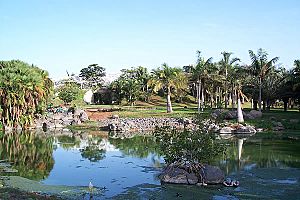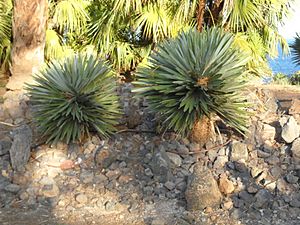Palmetum of Santa Cruz de Tenerife facts for kids
The Palmetum of Santa Cruz de Tenerife is a special botanical garden in Santa Cruz de Tenerife, Canary Islands, Spain. It covers a huge area of 120,000 square meters. This amazing garden is built on an artificial hill, which used to be a city landfill! From here, you can enjoy beautiful views of the ocean.
The Palmetum is famous for its incredible collection of palm trees, with about 600 different kinds. It also has many other plants, all organized by where they come from in the world. The garden uses no pesticides or fertilizers, making it a safe home for many wild birds. It first opened to the public in 2014 after years of hard work.
Contents
Where is the Palmetum?
The Palmetum is in Santa Cruz de Tenerife, the main city of the western Canary Islands. You can find it in the Cabo Llanos area, right next to the Parque Marítimo César Manrique. It's built on an artificial hill that was once a city dump, right by the sea. The weather here is usually warm, with an average temperature of about 21.7°C.
How the Palmetum Started
The old landfill closed down in 1983. The idea to turn it into a garden began in 1995. The European Union and the City of Santa Cruz de Tenerife helped pay for it. Experts like Manuel Caballero Ruano (an agronomist) and Carlo Morici (a biologist) guided the plant choices.
Carlos Simón, a landscape designer, helped build the lakes and waterfalls between 1996 and 1999. Work slowed down in 2000 because there wasn't enough money. But from 2007 to 2008, major improvements were made. The watering system was updated, and new parts of the garden were designed.
More work happened in 2010-2011, including building the entrance. Even before it fully opened, people could take guided tours in 2013. Finally, in 2014, the princes of Spain officially opened the Palmetum. It became a recognized botanical garden in 2015. Today, it's a popular spot for both locals and tourists, with school programs and partnerships with other gardens.
Buildings and Cool Spots
The Palmetum has a few interesting buildings and areas:
- Entrance Building: This is where you start your visit. It has a reception desk, a small shop, and a hall with a museum about palms. Offices are upstairs. A tower with a spiral staircase and an elevator connects the entrance to a bridge leading into the gardens.
- The Octagon (El Octógono): This is a large, partly underground shade house, covering 2,300 square meters. It's designed to protect the most delicate tropical plants. Inside, you'll find winding paths, small streams, bridges, and waterfalls.
- Ethnographical Palm Museum: This building is also partly underground and covered with plants. It's not finished yet, but it will display objects related to palms and dried plant samples. It will also have a lecture room for talks and events.
Amazing Plant Collections
As of 2016, the Palmetum has at least 1,853 different types of plants. It especially focuses on plants from islands around the world. A lot of these plants are rare or endangered. For example, 420 types of plants here are on the IUCN red list, meaning they are at risk. 73 of them are critically endangered, and 2 are even extinct in the wild!
The palm collection alone has 573 different kinds of palms. Many of these are also endangered. The Palmetum helps protect these rare palms. For example, it has 17 Coccothrinax borhidiana palms, which are very slow-growing and critically endangered. These palms are now producing seeds, helping to save their species.
The garden has one of the most complete collections of Caribbean palms in the world. This includes many types of Thrinax, Coccothrinax, and Hemithrinax. These plants were brought from expeditions and through partnerships with other botanical gardens, especially in the Caribbean.
World Sections in the Garden
The Palmetum is divided into "biogeographical sections." This means each area shows plants from a specific part of the world. These sections vary in size and often have their own hills, streams, or waterfalls. Here are some of the main sections:
- Canary Islands: This large area features plants native to the nearby Anaga mountains. You'll see many local species, including the famous Canary Islands date palms.
- Madagascar: This big section has a pond with mangroves and tall Bismarckia nobilis palms. You can also find rare palms like Ravenea xerophila and three Tahina spectabilis palms. An adult baobab tree, Adansonia za, planted in 1996, grows by the lake.
- Caribbean Islands: This is the largest section. It has the park's main square, surrounded by tall royal palms. A large waterfall flows into a pond with sandy shores and coconut palms. It's home to one of the world's biggest collections of Caribbean palms, especially Coccothrinax species.
- South America: A path here follows a stream, lined with large Attalea and Syagrus palms. You can also see important South American palms like the Pejibaye and Açai.
- Central America: This smaller section by the lake features large Sabal mauritiiformis and Swietenia macrophylla trees.
- New Caledonia: This section offers ocean views and has a grove of 50 Araucaria columnaris trees planted in 2001. You'll also find red leaf palms and other unique plants from New Caledonia.
- Melanesia: A smaller section with palms mainly from Fiji and Vanuatu. Look for large Carpoxylon, Veitchia vitiensis, and Pritchardia pacifica palms.
- Hawaii: This area showcases different types of Pritchardia, the only palm genus native to Hawaii. Other Hawaiian plants like Acacia koa and Hawaiian hibiscus also grow here.
- Australia: Most Australian palm types are found here. Two enormous Corypha utan palms are among the largest in the entire Palmetum.
- Asia: Key features include a majestic Ficus religiosa tree and a path with coconut palms overlooking the ocean. You'll also see the huge leaves of Corypha umbraculifera. Many Asian palm types and a collection of unusual banana trees are scattered throughout this section.
- Africa: This section has many Oil Palms and other famous African palms like Raphia, Borassus, and Hyphaene.
- Mascarene Islands: A small area with mature palms from genera like Acanthophoenix, Hyophorbe, Latania, and Dictyosperma.
Some sections, like those for New Guinea, Borneo, and the Philippines, were started later and are not yet open to the public.
See also
 In Spanish: Palmetum de Santa Cruz de Tenerife para niños
In Spanish: Palmetum de Santa Cruz de Tenerife para niños





